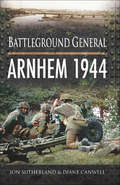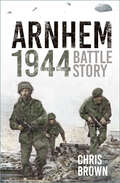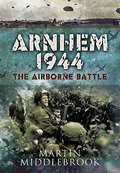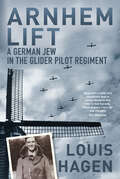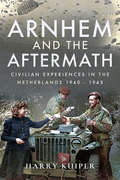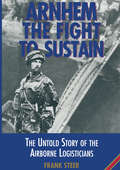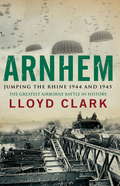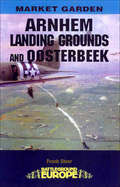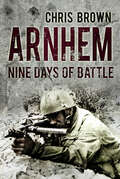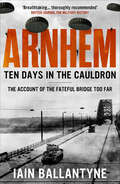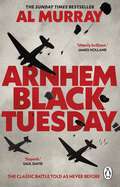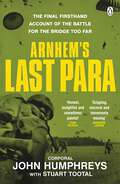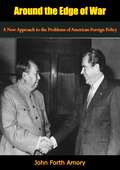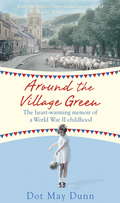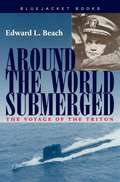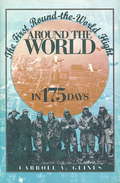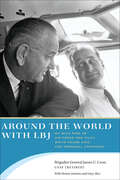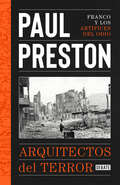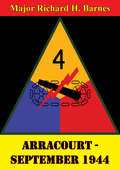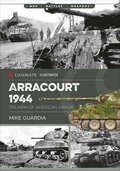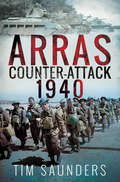- Table View
- List View
Arnhem 1944: Arnhem 1944 (Battleground General Ser.)
by Diane Canwell Jon SutherlandThis is the first in a series of game books which put you in command of the forces in engaged in some of history's most famous battles. Your tactical skill and ability to make the right command decision will be tested at every turn of the page. Operation Market Garden in September 1944 was one of the most daring Allied plans of the Second World War. An audacious surprise assault from the air, it was intended to give the Allies a bridgehead across the Rhine, removing the last significant natural barrier on the road to Berlin. If successful it might have shortened the war by months. Will the brave British paratroopers be able to seize the vital bridge at Arnhem and hold it until reinforcements fight their way through? Or will the Germans be able to recover the initiative and crush them in a skillful counterattack? The book presents you with a series of command decisions, aided by situation maps; directing you to the next relevant briefing depending on the option you choose. No dice are necessary to play, just this book and your tactical skill. When you buy this book, the fate of nations is in your hands.
Arnhem 1944: Battle Story
by Chris BrownThe Battle of Arnhem has acquired a near-legendary status in British military history as an audacious plan to land paratroopers into the Netherlands and spearhead an attack against the German-held Ruhr. Beyond images of brave paratroopers and scenes from A Bridge Too Far, this was in fact one of the most complex and strategically important operations of the war.It was expected that the British would sweep through and connect with the Arnhem force within a matter of days. But things on the ground proved very different. The Allied forces were isolated, without reinforcements and unable to advance. The operation ended in disaster. Using first-hand accounts, maps and detailed timelines, historian Chris Brown explores the unfolding action of the battle and puts the reader on the front line. If you truly want to understand what happened and why – read on.
Arnhem 1944: The Airborne Battle
by Martin MiddlebrookA detailed history of the World War II battle, featuring experiences from over 500 participants, by the author of The First Day on the Somme. The Battle of Arnhem was a turning point in the war, a gamble by Montgomery, using three airborne divisions to capture a series of bridges spanning the wide rivers of Holland and unleash the Allied armies into the plains of northern Germany. If the bridges had been captured and held, and the ground forces had been able to relieve the airborne forces, then there would have been a good chance of ending the war before Christmas, 1944. It all went wrong. Although the bridges taken by the Americans were relieved by ground troops, these troops could not reach Arnhem quickly enough. In the meantime, only a small part of the 1st British Airborne Division had reached the Arnhem Bridge. Most of the remainder of the airborne force was held up on the outskirts of the town by German units that turned out to be far stronger than expected—a major intelligence failure. After nine days of fighting, the survivors of the division were withdrawn across the Rhine, and it was not until many months later that ground forces captured Arnhem. Using the technique he has perfected over twenty-five years of military study, blending meticulous research based on original documents with the personal experiences of more than 500 participants, Martin Middlebrook describes the Battle of Arnhem from start to finish, from one end of that complicated battlefield to the other. He offers a masterly summary of what went wrong in the last major defeat in battle suffered by the British Army.
Arnhem 1944: The Human Tragedy of the Bridge Too Far
by Dilip SarkarThe airborne battle for the bridges across the Rhine at Arnhem ranks amongst the Second World Wars most famous actions inspiring innumerable books and the star-studded 1977 movie. This book, however, is unique: deeply moved, the author provides a fresh narrative and approach concentrating on the tragic stories of individual casualties.These men were killed at different junctures in the fighting, often requiring forensic analysis to ascertain their fates. Wider events contextualize the authors primary focus - effectively resurrecting casualties through describing their backgrounds, previous experience, and tragic effect on their families. In particular, the emotive and unresolved issue of the many still missing is explored.During the course of his research, the author made numerous trips to Arnhem and Oosterbeek, traveled miles around the UK, and spent countless hours communicating with the relatives of casualties achieving their enthusiastic support. This detailed work, conducted sensitively and with dignity, ensures that these moving stories are now recorded for posterity.Included are the stories of Private Albert Willingham, who sacrificed his life to save civilians; Major Frank Tate, machine-gunned against the backdrop of blazing buildings around Arnhem Bridge; family man Sergeant George Thomas, whose antitank gun is displayed today outside the Airborne Museum Hartenstein, and Squadron Leader John Gilliard DFC, father of a baby son who perished flying his Stirling through a hail of shot and shell during an essential re-supply drop. Is Private Gilbert Anderson, who remains missing, actually buried as an unknown, the author asks? Representing the Poles is Lance-Corporal Czeslaw Gajewnik, who drowned whilst escaping the hell of Oosterbeek, and accounts by Dutch civilians emphasize the shared suffering sharply focussed by the tragedy of Luuk Buist, killed protecting his family. The sensitivity still surrounding German casualties is also explained.This raw, personal, side of war, the hopes and fears of ordinary men thrust into extraordinary circumstances, is both deeply moving and revealing: no longer are these just names carved on headstones or memorials in a distant land. Through this thorough investigative work, supported by those who remember them, the casualties live again, their silent voices heard through friends, relatives, comrades and unpublished letters.So, let us return to the fateful autumn of 1944, and meet those fighting in the skies, on the landing grounds, in the streets and woods of Oosterbeek, and on the bridge too far at Arnhem.Now, the casualties can tell their own stories as we join this remarkable journey of discovery.
Arnhem Lift: A German Jew in the Glider Pilot Regiment
by Louis HagenOf the 10,000 men who landed at Arnhem, over nine days 1,400 were killed and more than 6,000 – about a third of them wounded – were captured. It was a bloody disaster. The remarkable Louis Hagen, an ‘enemy alien’ who had escaped to England having been imprisoned and tortured in a Nazi concentration camp as a boy just a few years earlier, was one of the minority who made it back. What makes this book so unforgettable is not only the breathtaking drama of the story itself, it is the unmistakable talent of the writer. The narrative was first published anonymously in 1945.45 years later at a dinner party in Germany, Louis Hagen met Major Winrich Behr, Adjutant to Field Marshal Model at Arnhem. Louis added his side of the story to add even more insight to the original work.
Arnhem and the Aftermath: Civilian Experiences in the Netherlands 1940-1945
by Harry KuiperWar is far more than a series of military victories and defeats. Civilians always are the biggest victims and there are often staggering imbalances between casualties on the frontlines, and those behind; between the victims and the aggressors. According to recent figures, The Second World War saw the deaths of an estimated 72 million people worldwide, two thirds of whom were civilians. Wars also have serious social, economic and human consequences. They may defeat politicians and aggressive politics, but it is communities who pay the price. In 1939 one European country after another suffered defeat, which later resulted in enormous social and economic degradations of the communities involved. The failure of Operation Market Garden in 1944 resulted in yet another tragedy for the Dutch and one that would have far deeper social consequences than those before it. After the Allies were defeated, the Nazis terrorised the local Dutch populace and the V2 rockets fired immediately from their Dutch launch sites resulted in over 9,000 casualties in the UK.Arnhem and the Aftermath begins and ends in Arnhem, in 1940 and 1945 respectively. It focuses on the experiences of the civilians in those mournful years, against a back-drop of all three airborne operations in the Netherlands, in which both German and Allied forces were involved.
Arnhem the Fight to Sustain: The Untold Story of the Airborne Logisticians
by Frank SteerOn the ground the airborne logisticians at the battle of Arnhem fought to the bitter end, indistinguishable from their paratroop comrades. In the air, their deeds and sacrifice were shining examples of duty done under the most desperate circumstances. Witness the account of Flight Lieutenant H J King, navigator of Dakota KG 374 of 271 squadron RAF, Down Ampney:These men were not volunteers like aircrew. They received no flyingpay, yet were, without doubt, superb in their fulfilment of duty even though KG 374 was burning for the whole period over the dropping zone. Arnhem—The Fight To Sustain tells the stirring story of the men and the methods employed in sustaining 1st Airborne Division. It is the first account of forming corps of today's Royal Logistic Corps in action together.Following extensive research the story draws heavily on contemporary documents and eyewitness accounts and is lavishly illustrated.
Arnhem: Jumping the Rhine 1944 & 1945
by Lloyd ClarkAn insightful and gripping account of the largest airborne operation in history. In September 1944, the river Rhine was a serious barrier to the advancing Allied armies in the West who were intent on charging Berlin and ending the war. Field Marshal Bernard Montgomery decided to utilise the First Allied Airborne Army consisting of British, American and Polish troops. Codenamed Operation Market Garden, 40,000 paratroopers were dropped behind enemy lines while ground forces linked to relieve them. But, due to bad weather and German resistance, the operation failed. In March 1945, asecond attempt was planned: Operation Varsity Plunder. This time the plan worked. Despite extremely heavy fighting, they cracked the German line.
Arnhem: Jumping the Rhine 1944 & 1945
by Lloyd ClarkAn insightful and gripping account of the largest airborne operation in history. In September 1944, the river Rhine was a serious barrier to the advancing Allied armies in the West who were intent on charging Berlin and ending the war. Field Marshal Bernard Montgomery decided to utilise the First Allied Airborne Army consisting of British, American and Polish troops. Codenamed Operation Market Garden, 40,000 paratroopers were dropped behind enemy lines while ground forces linked to relieve them. But, due to bad weather and German resistance, the operation failed. In March 1945, asecond attempt was planned: Operation Varsity Plunder. This time the plan worked. Despite extremely heavy fighting, they cracked the German line.
Arnhem: Landing Grounds And Oosterbeek (Battleground Europe)
by Frank SteerThis is the latest in the well-respected Battleground series of books, and covers a number of aspects of the battle of Arnhem. It concentrates on the landings and the desperate and legendary battle fought by the remnants of 1st Airborne Division in the town of Oosterbeek. The book relies on both historical knowledge and anecdotes from veterans to bring to life the events of those fateful days of late September 1944.Having set the strategic scene in the opening chapter, the guide suggests four separate tours around the area, one on foot and the others requiring a car. They can all be completed in a full day, but are structured in such a way that visitors can make their own choice of how and where to visit. For a clear, concise and accurate account of the Arnhem-Oosterbeek battlefield this excellent addition to our Battleground series is unlikely to be beaten.
Arnhem: Nine Days of Battle
by Chris BrownThe greatest airborne operation in history commenced on 17 September 1944. Nine days later nearly four out five of the British 1st Airborne Division and their Polish comrades would be killed, wounded or captured as Germany secured her last great battlefield victory of the war. The ferocious and gallant actions in Arnhem and Oosterbeek have fascinated historians and students ever since. Drawing extensively on eye-witness experience and unit diaries, and providing a detailed tactical and technical analysis of the arms, equipment and practices of the day, Arnhem: Nine Days of Battle provides a fascinating day-on-day account of one of the most iconic actions of the Second World War. Supported by battle maps, timelines, troop diagrams as well as touring guides – this is the perfect companion for the armchair historian or the intrepid battlefield traveller.
Arnhem: Ten Days in the Cauldron
by Iain BallantyneThe account of the fateful bridge too far…‘It was a bridge too far and perhaps the whole plan was doomed to failure from the start, but we had to try, didn’t we?’17 September 1944: 30,000 airborne soldiers prepare to drop 64 miles behind enemy lines into Nazi-occupied Holland; tens of thousands of ground troops race down Hell’s Highway in tanks and armoured cars, trucks and half-tracks to link up with them. The goal – to secure eight bridges across the Rhine and end the war by Christmas. Ten days later, over 15,000 of these soldiers have died, 6,000 have been taken prisoner.Operation Market Garden was the daring plan to stage a coup de main in occupied territory, gain control of those bridges, and obtain a direct route into Hitler’s Germany. But the operation failed and the allied forces suffered a brutal military defeat.In the 75 years since, tactics have been analysed and blame has been placed, but the heart of Arnhem’s story lies in the selflessness and bravery of those troops that fought, the courage and resilience of the civilians caught up in confrontation, and the pure determination to fight for their lives and their freedom. This is the story of ordinary people caught up in extraordinary events.In Ballantyne’s Arnhem, we go into battle with not only the famous commanders in the thick of the action, but also with all those whose fates were determined by their decisions. Based on first-hand interviews, military records, and diaries, we witness the confusion and mayhem of war – from the horrific and devastating to the surreal and mundane. But most of all, we witness the self-sacrifice and valour of the men who gave their lives to liberate strangers in a foreign country.Praise for Arnhem: Ten Days in the Cauldron‘Reminiscent of Stephen Ambrose at his best… some remarkable stories, which Ballantyne neatly dovetails into a rolling epic’ Dr Harry Bennett, University of Plymouth‘Breath-taking… I thoroughly enjoyed reading this account of Arnhem, adding, if you like, a trench-level perspective to those other accounts written from more senior, and sometimes more detached, points of view. Thoroughly recommended’ British Journal for Military History
Arnhem: The Classic World War II Battle Told As Never Before
by Al MurrayDiscover the Sunday Times bestseller and incredible true story behind the most catastrophic 24-hours the British military faced in World War II from the bestselling author.‘Utterly brilliant... this book really is the last word on the Battle of Arnhem’ James Holland’Superb... A military historian of originality and insight to compare with the best’ Saul David_________The Battle of Arnhem is one of the best-known stories in British military history: a daring but doomed attempt to secure a vital bridgehead across the Rhine in order to end the war before Christmas 1944.It is always written about, with the benefit of unerring 20/20 hindsight, as being destined to fail, but the men who fought there, men of military legend, didn't know that that was to be their fate.Now, in Arnhem: Black Tuesday, Al Murray focuses on the events of one day as they happened through the eyes of the British participants, without bringing any knowledge of what would happen tomorrow to bear, offering a very different perspective on a familiar narrative.Some things went right and a great many more went wrong, but recounting them in this way allows the reader to understand for the first time how certain decisions were taken in the moment and how opportunities were squandered.Al Murray has always been obsessed by this legendary battle, and in Arnhem: Black Tuesday he showcases all of his knowledge, interpretation and enthusiasm to bear to tell the story of one of history’s great heroic failures differently for the first time._________Praise for Arnhem: Black Tuesday:‘Original and insightful’ Telegraph'A revelation.. This is Arnhem unplugged. By confining himself to men in and around Arnhem on that Tuesday, Murray achieves something special' The Times
Arnhem’s Last Para: A British Paratrooper’s Memoir from Tobruk to Arnhem in World War II, for fans of The Bridge Too Far
by Stuart Tootal John HumphreysTHE FINAL LIVING TESTIMONY FROM THE ARNHEM BRIDGE - A LEGENDARY SOLDIER’S STORY, TOLD IN HIS OWN WORDSBy former paratrooper John Humphreys and bestselling author and ex-Parachute Regiment officer Stuart Tootal'A gripping, visceral and immensely moving read. Courage beyond measure, coupled with humility to act as a lesson to us all. No more fitting tribute – we remember them' Damien Lewis--A powerful and authentic account of one soldier's war from Tobruk to Arnhem and all points in between.John Humphreys was just a boy soldier in the Royal Engineers when war was declared in 1939. By the war's end he had jumped into Arnhem with the Parachute Regiment to spearhead the attack on the bridge. For days Humphreys and the rest of his squad held on, outnumbered and outgunned by the German army fighting to the last bullet and refusing to surrender.But the Bridge Too Far is only the climax of Humphreys’ remarkable war. Twice captured as a prisoner of war, he twice escaped from the enemy to make his way back to Allied lines in order to rejoin the fight.Aged 101, Humphreys began to pen his extraordinary story, with the help of bestselling author and former paratrooper Stuart Tootal. The Arnhem’s Last Para is Humphrey’s parting gift, and the final time we will read an account from a soldier of our Greatest Generation bearing witness to the heroism and sacrifice of this legendary action – told with incredible honesty and irrepressible spirit.
Around the Edge of War: A New Approach to the Problems of American Foreign Policy
by John Forth AmoryWith Around the Edge of War: A New Approach to the Problems of American Foreign Policy, John Forth Amory wrote a thought-provoking book examining several approaches to United States foreign policy. A Washington expert at the time of first publication in 1961, Amory was critical of the tendency in Washington to “over-think” a problem, and advocated a return to Jeffersonian principles as a beginning in the search of reasonable alternatives to present policy.“Our primary purpose is to help Americans think about our foreign policy as a whole, about how it is made, whence derived, and whether it has been right or wrong in terms of the whole national interest and pragmatically in terms of results. We want especially to lead Americans to think of people, of men, women and children; for we believe that in this period of military stalemate the only remaining weapons that can be used, for or against us, are the people of the earth, whom Jefferson defined as the only legitimate source of power—the great majorities who, after millennia, are coming into their own. We think that the safety of the United States, the moral health of the American people and the survival of our national freedoms depend on whether we go with this swelling tide of people or against it.”—John Forth Amory, Foreword
Around the Village Green: The Heart-Warming Memoir of a World War II Childhood
by Dot May DunnIt's 1939 and little Dot May Dun is playing with her brothers in the quiet lanes of their Derbyshire village. The grown-ups' talk of war means very little to Dot but things are starting to change in the village, for good. When a prisoner of war camp is built close to Dot's village, and a Yankee base is stationed nearby, Dot makes friends with the most unlikely of soldiers. But her friendships are threatened when telegrams start to arrive in the village and the real impact of war bears heavily on this close-knit mining community. From little lives spring great tales. Dot's childhood memoir shares the universals of innocence, love, loss and friendships. THE VILLAGE will move and entertain in equal measures.
Around the Village Green: The Heart-Warming Memoir of a World War II Childhood
by Dot May DunnThe heart-warming tale of a wartime childhood.It's 1939 and little Dot May Dun is playing with her brothers in the quiet lanes of their Derbyshire village. The grown-ups' talk of war means very little to Dot but things are starting to change in the village, for good.When a prisoner of war camp is built close to Dot's village, and a Yankee base is stationed nearby, Dot makes friends with the most unlikely of soldiers. But her friendships are threatened when telegrams start to arrive in the village and the real impact of war bears heavily on this close-knit mining community.From little lives spring great tales. Dot's childhood memoir shares the universals of innocence, love, loss and friendships. THE VILLAGE will move and entertain in equal measures.
Around the Village Green: The Heart-Warming Memoir of a World War II Childhood
by Dot May DunnIt's 1939 and little Dot May Dun is playing with her brothers in the quiet lanes of their Derbyshire village. The grown-ups' talk of war means very little to Dot but things are starting to change in the village, for good.When a prisoner of war camp is built close to Dot's village, and a Yankee base is stationed nearby, Dot makes friends with the most unlikely of soldiers. But her friendships are threatened when telegrams start to arrive in the village and the real impact of war bears heavily on this close-knit mining community.From little lives spring great tales. Dot's childhood memoir shares the universals of innocence, love, loss and friendships. THE VILLAGE will move and entertain in equal measures.Read by Joan Walker(p) 2014 Orion Publishing Group
Around the World Submerged
by Edward L. BeachWhen the nuclear-powered submarine USS Triton was commissioned in November 1959, its commanding officer, Captain Edward L. Beach, planned a routine shakedown cruise in the North Atlantic. Two weeks before the scheduled cruise, however, Beach was summoned to Washington and told of the immediate necessity to prove the reliability of the Rickover-conceived submarine. His new secret orders were to take the Triton around the world, entirely submerged the total distance.This is Beach's gripping firsthand account of what went on during the 36,000 nautical-mile voyage whose record for speed and endurance still stands today. It brings to life the many tense events in the historic journey: the malfunction of the essential fathometer that indicated the location of undersea mountains and shallow waters, the sudden agonizing illness of a senior petty officer, and the serious problems with the ship's main hydraulic oil system. Intensely dramatic, Beach's chronicle also describes the psychological stresses of the journey and some touching moments shared by the crew. A skillful story teller, he recounts the experience in such detail that readers feel they have been along for the ride of a lifetime.
Around the World in 175 Days
by Walter J. Boyne Carroll V. GlinesAmerican military aviation reached a low point after World War I, lagging behind its European counterparts and facing a peacetime battle for survival. To raise the public profile of aviation, military leaders encouraged their pilots to enter air shows and vie for speed, endurance, and altitude records. As a result, U.S. Army airmen daringly accomplished the first flight around the world in 1924, three years before Charles Lindbergh's famous solo flight.In Around the World in 175 Days, Carroll V. Glines recounts this adventure from the golden age of aviation. After two years of planning, four Douglas World Cruisers, each carrying a pilot and a mechanic, took off from Seattle in April 1924, flying west to circle the globe; one additional plane was held in reserve. Four of the men and two of the planes completed the flight in September 1924 and, miraculously, all eight men survived, even though one plane had crashed in the Alaskan mountains and another had ditched in the Atlantic. The airmen had triumphed over the weather extremes of Arctic Alaska and the desert Middle East, numerous primitive landing sites in rough terrain, and maintenance and supply problems that persisted despite the coordinated efforts of land- and sea-based support personnel from the Army Air Service, U.S. Navy, and U.S. Coast Guard.Glines captures the drama of the journey, from the careful behind-the-scenes planning through the airmen's harrowing in-flight experiences to the mission's culmination in triumph. The success charted the future of the Army Air Service's worldwide aircraft deployment and paved the way for long-distance commercial air travel.
Around the World with LBJ: My Wild Ride as Air Force One Pilot, White House Aide, and Personal Confidant
by James U. Cross Denise Gamino Gary RiceWhen Lyndon Baines Johnson wanted to go somewhere, there was no stopping him. This dynamic president called for Air Force One as others summon a taxi—at a moment’s notice, whatever the hour or the weather. And the man who made sure that LBJ got his ride was General James U. Cross, the president’s hand-picked pilot, top military assistant, and personal confidante. One of the few Air Force One pilots to have a position, simultaneously, in the White House, General Cross is also the only member of LBJ’s inner circle who has not publicly offered his recollections of the president. In this book, he goes on the record, creating a fascinating, behind-the-scenes portrait of America’s complex, often contradictory, always larger-than-life thirty-sixth president. General Cross tells an engrossing story. In addition to piloting Air Force One around the globe, he served President Johnson in multiple capacities, including directing the Military Office in the White House; managing a secret two-million-dollar presidential emergency fund; supervising the presidential retreat at Camp David, the president’s entire transportation fleet, and the presidential bomb shelters; running the White House Mess; hiring White House social aides, including the president’s future son-in-law, Charles Robb; and writing condolence letters to the families of soldiers killed in Vietnam. This wide-ranging, around-the-clock access to President Johnson allowed Cross to witness events and share moments that add color and depth to our understanding of America’s arguably most demanding and unpredictable president.
Arquitectos del terror: Franco y los artífices del odio
by Paul PrestonVuelve Paul Preston con otro libro imprescindible para entender nuestra historia reciente. La Guerra Civil se libró para anular las reformas educativas y sociales de la Segunda República y para combatir su cuestionamiento del orden establecido. Los rebeldes lucharon a favor de los terratenientes, industriales, banqueros, clérigos y oficiales del Ejército, cuyos intereses se habían visto amenazados, y en contra de los liberales e izquierdistas que impulsaban las reformas. Sin embargo, en los años de república, de 1931 a 1936, a lo largo de la guerra y durante muchas décadas después, se siguió fomentando en España el mito de que el enemigo derrotado en la contienda era el contubernio judeomasónico y bolchevique. No obstante, el presente libro no es una historia del contubernio, del antisemitismo ni de la antimasonería en España, sino que adopta la forma de pequeñas biografías de las principales figurasantisemitas y antimasónicas que propagaron ese mito, y de los personajes centrales que pusieron en práctica los horrores que este justificaba. Desmontar sus falsedades es uno de los objetivos fundamentales de esta obra.
Arracourt - September 1944
by Major Richard H. BarnesThis thesis analyzes the political role of the German General Staff as well as civil military relations in Germany from the late 19th century until 1933. Specifically, it examines the rise and fall of Kurt von Schleicher. Together with Generals Paul von Hindenburg, Erich Ludendorff, and Wilhelm Groener, Schleicher shaped the politics of the Weimar Republic, right up to the end that he--unintentionally--hastened when his intrigues paved the way for Adolf Hitler's dictatorship.During World War I, the German army completed its control over the civilian administration and bureaucracy. In the Republic of Weimar 1919-1933, the military remained a powerful governmental player--as the self-anointed protector of the nation against external and internal threats, including democracy.Thus, Germany's political situation in the winter of 1932-1933 and the activities of the key players stemmed from a long-term anti-democratic socialization process amid an entrenched civil-military imbalance. As the present thesis demonstrates, Schleicher's life--from his military background to his experience as a member of Prussia's noble Junker class--coincided with Germany's tumultuous modernization. The fateful lessons that he drew from this experience ultimately spelled the end of Germany's first democracy and ushered in the calamity of the Third Reich.
Arracourt 1944: Triumph of American Armor (Casemate Illustrated)
by Mike GuardiaA photo-packed account of how the tanks of 4th Armored Division defeated two panzer brigades over eleven days of battle at Arracourt: &“An enjoyable read.&” —AMPS September 1944: With the Allies closing in on the Rhine, Adolf Hitler orders a counterattack on General Patton&’s Third Army in France. Near the small French town of Arracourt, elements of the US 4th Armored Division meet the grizzled veterans of the 5th Panzer Army in combat. Atop their M4 Shermans, American tank crews square off against the technologically superior Mark V Panther tanks of the Wehrmacht. Yet through a combination of superior tactics, leadership, teamwork, and small-unit initiative, the outnumbered American forces win a decisive victory against the 5th Panzer Army. Indeed, of the 262 tanks and mobile assault guns fielded by German forces at Arracourt, 200 were damaged or destroyed by enemy fire. The Americans, by contrast, lost only 48 tanks. Following the collapse of the German counterattack, Patton&’s Third Army found itself within striking distance of the Third Reich&’s borderlands. The battle of Arracourt was the US Army&’s largest tank battle until the Ardennes Offensive in December 1944. It helped pave the way for the final Allied assault into Germany, and showed how tactical ingenuity and adaptive leadership can overcome an enemy&’s superior size or technological strength. This extensively illustrated book recounts the dramatic story. &“An interesting study of small-unit leadership that emphasizes the importance of tank-crew training, the value of a reliable logistics system and effects of weather on battlefield activities.&” —ARMOR Magazine &“This well-written book explains how U.S. forces won this critical battle.&” —WWII History Magazine &“Enjoyable . . . includes some nicely done full color profiles of some of the tanks involved.&” —ModelingMadness.com
Arras Counter-Attack, 1940
by Tim SaundersOn 21 May 1940 during the ill-fated Dunkirk Campaign the British launched an operation spearheaded by two tank regiments to help secure the city of Arras. This was the only significant armored operation mounted by the British during the campaign.Poorly coordinated and starting badly, the Matilda tanks ran into the flanks of Rommels over-extended 7th Panzer Division. With the German antitank guns, unable to penetrate the armor of the British tanks, Rommels infantry fell into chaos as the Matildas plunged deep into their flank. The Germans were machine-gunned and started to surrender in large numbers but with the British infantry lagging well behind, fighting their own battles in the villages, there was no one to round them up.Into this scene of chaos entered Rommel whose personal leadership and example started to steady his troops and organize an effective response, despite being spattered with the brains of his aide de camp. This was classic Rommel but in the aftermath, he claimed to have been attacked by five divisions.The Arras counterattack contributed to Hitler issuing the famous halt order to his Panzers that arguably did much to allow the British Army to withdraw to Dunkirk and escape total destruction.
